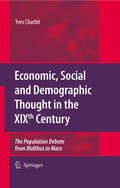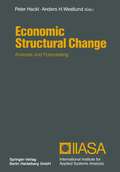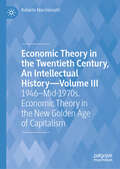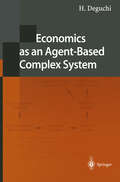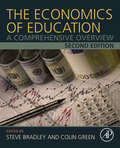- Table View
- List View
Economic, Social and Demographic Thought in the XIXth Century: The Population Debate from Malthus to Marx
by Yves CharbitAccording to current understanding, Malthus was hostile to an excess of population because it caused social sufferings, while Marx was favourable to demographic growth in so far as a large proletariat was a factor aggravating the contradictions of capitalism. This is unfortunately an oversimplification. Both raised the same crucial question: when considered as an economic variable, how does population fit into the analysis of economic growth? Even though they started from the same analytical standpoint, Marx established a very different diagnosis from that of Malthus and built a social doctrine no less divergent. The book also discusses the theoretical and doctrinal contribution of the liberal economists, writing at the onset of the industrial revolution in France (1840-1870), and those of their contemporary, Pierre-Joseph Proudhon, who shared with Marx the denunciation of the capitalist system. By paying careful attention to the social, economic, and political context, this book goes beyond the shortcomings of the classification between pro- and anti-populationism. It sheds new light over nineteenth century controversies over population in France, a case study for Europe.
Economic Structural Change: Analysis and Forecasting
by Peter Hackl Anders H. WestlundStructural change is a fundamental concept in economic model building. Statistics and econometrics provide the tools for identification of change, for estimating the onset of a change, for assessing its extent and relevance. Statistics and econometrics also have de veloped models that are suitable for picturing the data-generating process in the presence of structural change by assimilating the changes or due to the robustness to its presence. Important subjects in this context are forecasting methods. The need for such methods became obvious when, as a consequence of the oil price shock, the results of empirical analyses suddenly seemed to be much less reliable than before. Nowadays, economists agree that models with fixed structure that picture reality over longer periods are illusions. An example for less dramatic causes than the oil price shock with similarly profound effects is economic growth and its impacts on the economic system. Indeed, economic growth was a motivating concept for this volume. In 1983, the International Institute for Applied Systems Analysis (IIASA) in Laxen burg/ Austria initiated an ambitious project on "Economic Growth and Structural Change".
Economic Systems Analysis: Statistical Indicators (Studies in Systems, Decision and Control #158)
by Elena V. Sibirskaya Lyudmila V. Oveshnikova Lilia A. Mikheykina Innara R. LyapinaThis book explores a wide range of issues related to the methodology, organization, and technologies of analytical work, showing the potential of using analytical tools and statistical indicators for studying socio-economic processes, forecasting, organizing effective companies, and improving managerial decisions. At the level of “living knowledge” in the broad context, it describes the essence of analytical technologies and means of applying analytical and statistical work. The book is of interest to readers regardless of their specialization: scientific research, medicine, pedagogics, law, administrative work, or economic practice. Starting from the premise that readers are familiar with the theory of statistics, which has formulated the general methods and principles of establishing the quantitative characteristics of mass phenomena and processes, it describes the concepts, definitions, indicators and classifications of socio-economic statistics, taking into consideration the international standards and the present-day practice of statistics in Russia. Although concise, the book provides plenty of study material as well as questions at the end of each chapter It is particularly useful for those interested in self-study or remote education, as well as business leaders who are interested in gaining a scientific understanding of their financial and economic activities.
Economic Theories and their Relational Structures: A Model-Theoretic Characterization
by E. KleinAn examination of the foundations of contemporary theoretical economics. Applying concepts from model theory - formal semantics - and standard tools in foundations research the author aims three targets, namely, a characterization of the notion 'empirical economic theory', the determination of the epistemological and methodological status of an important class of 'non-empirical' theories in economics, and the proposal of a taxonomy of economic theories based upon intended epistemological status and the descriptive or operative function of a theory.
Economic Theory in the Twentieth Century, An Intellectual History—Volume III: 1946–Mid-1970s. Economic Theory in the New Golden Age of Capitalism
by Roberto MarchionattiThis book, set out over four-volumes, provides a comprehensive history of economic thought in the 20th century. Special attention is given to the cultural and historical background behind the development of economic theories, the leading or the peripheral research communities and their interactions, and a critical appreciation and assessment of economic theories throughout these times.Volume III addresses economic theory in the period of the new golden age of capitalism, between the years from the end of the Second World War to the mid1970s, which saw the establishment of the new mainstream, in particular in its Harvard-MIT-Cowles version. It was the period of the pre-eminence of the Neoclassical Keynesian Synthesis—the theoretical core of the period’s dominant school of thought.This work provides a significant and original contribution to the history of economic thought and gives insight to the thinking of some of themajor international figures in economics. It will appeal to students, scholars and the more informed reader wishing to further their understanding of the history of the discipline.
The Economic Valuation of Green Electricity (SpringerBriefs in Environmental Science)
by Simona Bigerna Paolo PolinoriThe aim of this book is to analyze the relationship between renewable energy sources and citizens, focusing both on demand and supply. Today, the consequences regarding the use of fossil energy are seen from a different perspective because the issues related to climate change are evident worldwide. Thus, climate change and resource depletion are real problems to be addressed for the welfare of society. Renewable energy sources (RES) are essential to reduce polluting emissions, but they can produce a range of environmental effects which might be detrimental to human activities as attested by the several types of the Nimby effect (“Not In My Back Yard”). This is because infrastructure siting usually offers different pros and cons to stakeholders and the local populations affected. Nevertheless empirical evidence shows that in many countries, society is willing to pay a significant amount to facilitate adoption of renewable technologies. With RES, citizens are called on to play a dual role – not only that of end consumers but often also stakeholders in the local production process. In this book we try to deal with this dual role played by the citizens to evaluate the actual public acceptance of RES. We address a specific and important area of the economic analysis: willingness to pay (WTP) and willingness to accept (WTA). The research evaluates the attitude of citizens towards the end use of green energy by investigating the likelihood of acceptance of a new infrastructures related to RES production. The book, therefore, is not about how to reconcile consumers and citizens, rather it explores the main determinants of peoples' behavior for a better understanding of this phenomenon.
Economics: for Cambridge International AS & A Level (pdf)
by Colin Bamford Susan GrantThis series supports teachers and learners of Cambridge International AS & A Level Economics (9708). Introduce your learners to the world of economics with the fourth edition of our Cambridge International AS & A Level Economics series. Featuring a coursebook with digital access, digital coursebook, workbook with digital access and digital teacher's resource, your students will gain a clear understanding of how economics operates on an international scale, while developing key skills, such as analysis and evaluation.
Economics and Computation: An Introduction to Algorithmic Game Theory, Computational Social Choice, and Fair Division (Springer Texts in Business and Economics)
by Irene RotheThis textbook connects three vibrant areas at the interface between economics and computer science: algorithmic game theory, computational social choice, and fair division. It thus offers an interdisciplinary treatment of collective decision making from an economic and computational perspective. Part I introduces to algorithmic game theory, focusing on both noncooperative and cooperative game theory. Part II introduces to computational social choice, focusing on both preference aggregation (voting) and judgment aggregation. Part III introduces to fair division, focusing on the division of both a single divisible resource ("cake-cutting") and multiple indivisible and unshareable resources ("multiagent resource allocation"). In all these parts, much weight is given to the algorithmic and complexity-theoretic aspects of problems arising in these areas, and the interconnections between the three parts are of central interest.
Economics and Computation: An Introduction to Algorithmic Game Theory, Computational Social Choice, and Fair Division (Classroom Companion: Economics)
This textbook connects three vibrant areas at the interface between economics and computer science: algorithmic game theory, computational social choice, and fair division. It thus offers an interdisciplinary treatment of collective decision making from an economic and computational perspective. Part I introduces to algorithmic game theory, focusing on both noncooperative and cooperative game theory. Part II introduces to computational social choice, focusing on both preference aggregation (voting) and judgment aggregation. Part III introduces to fair division, focusing on the division of both a single divisible resource ("cake-cutting") and multiple indivisible and unshareable resources ("multiagent resource allocation"). In all these parts, much weight is given to the algorithmic and complexity-theoretic aspects of problems arising in these areas, and the interconnections between the three parts are of central interest.
Economics and Construction (Building and Surveying Series)
by Andrew CookeA clearly written and self-contained introductory textbook that presents the principles of economics for non-specialist students of the built environment. Using relevant examples, it shows how economics can provide a logical framework within which construction activity can be analysed. The text assumes no prior exposure to economics and aims to give readers the confidence to use economics at the microeconomic and macroeconomic levels.
The Economics and Econometrics of the Energy-Growth Nexus
by Angeliki MenegakiThe Economics and Econometrics of the Energy-Growth Nexus recognizes that research in the energy-growth nexus field is heterogeneous and controversial. To make studies in the field as comparable as possible, chapters cover aggregate energy and disaggregate energy consumption and single country and multiple country analysis. As a foundational resource that helps researchers answer fundamental questions about their energy-growth projects, it combines theory and practice to classify and summarize the literature and explain the econometrics of the energy-growth nexus. The book provides order and guidance, enabling researchers to feel confident that they are adhering to widely accepted assumptions and procedures.Provides guidance about selecting and implementing econometric tools and interpreting empirical findings Equips researchers to get clearer pictures of the most robust relationships between variables Covers up-to-date empirical and econometric methodsCombines theory and practice to classify and summarize the literature and explain the econometrics of the energy-growth nexus
The Economics and Finance of Commodity Price Shocks (Banking, Money and International Finance)
by Mikidadu MohammedThe behaviour of commodity prices never ceases to marvel economists, financial analysts, industry experts, and policymakers. Unexpected swings in commodity prices used to occur infrequently but have now become a permanent feature of global commodity markets. This book is about modelling commodity price shocks. It is intended to provide insights into the theoretical, conceptual, and empirical modelling of the underlying causes of global commodity price shocks. Three main objectives motivated the writing of this book. First, to provide a variety of modelling frameworks for documenting the frequency and intensity of commodity price shocks. Second, to evaluate existing approaches used for forecasting large movements in future commodity prices. Third, to cover a wide range and aspects of global commodities including currencies, rare-hard-lustrous transition metals, agricultural, energy, and health pandemics. Some attempts have already been made towards modelling commodity price shocks. However, most tend to narrowly focus on a subset of commodity markets, i.e., agricultural commodities market and/or energy market. In this book, the author moves the needle forward by operationalizing different models, which allow researchers to identify the underlying causes and effects of commodity price shocks. Readers also learn about different commodity price forecasting models. The author presents the topics to readers assuming less prior or specialist knowledge. Thus, the book is accessible to industry analysts, researchers, undergraduate and graduate students in economics and financial economics, academic and professional economists, investors, and financial professionals working in different sectors of the commodity markets. Another advantage of the book’s approach is that readers are not only exposed to several innovative modelling techniques to add to their modelling toolbox but are also exposed to diverse empirical applications of the techniques presented.
The Economics and Finance of Commodity Price Shocks (Banking, Money and International Finance)
by Mikidadu MohammedThe behaviour of commodity prices never ceases to marvel economists, financial analysts, industry experts, and policymakers. Unexpected swings in commodity prices used to occur infrequently but have now become a permanent feature of global commodity markets. This book is about modelling commodity price shocks. It is intended to provide insights into the theoretical, conceptual, and empirical modelling of the underlying causes of global commodity price shocks. Three main objectives motivated the writing of this book. First, to provide a variety of modelling frameworks for documenting the frequency and intensity of commodity price shocks. Second, to evaluate existing approaches used for forecasting large movements in future commodity prices. Third, to cover a wide range and aspects of global commodities including currencies, rare-hard-lustrous transition metals, agricultural, energy, and health pandemics. Some attempts have already been made towards modelling commodity price shocks. However, most tend to narrowly focus on a subset of commodity markets, i.e., agricultural commodities market and/or energy market. In this book, the author moves the needle forward by operationalizing different models, which allow researchers to identify the underlying causes and effects of commodity price shocks. Readers also learn about different commodity price forecasting models. The author presents the topics to readers assuming less prior or specialist knowledge. Thus, the book is accessible to industry analysts, researchers, undergraduate and graduate students in economics and financial economics, academic and professional economists, investors, and financial professionals working in different sectors of the commodity markets. Another advantage of the book’s approach is that readers are not only exposed to several innovative modelling techniques to add to their modelling toolbox but are also exposed to diverse empirical applications of the techniques presented.
Economics and Power-intensive Industries (SpringerBriefs in Applied Sciences and Technology)
by Helga KristjánsdóttirDelving into the connections between renewable energy and economics on an international level, this book focuses specifically on hydropower and geothermal power production for use in the power intensive industry. It takes readily available government and international statistics to provide insight into how businesses and economists can interpret the factors that influence the growth of power intensive industries. It also discusses the CarbFix and SulFix projects that involve the injection of hydrogen sulphide (H2S), and carbon dioxide (CO2) back to reservoir as an emission reduction method. With improved engineering processes, both types of power generation are increasingly subject to economies of scale. These exciting technological developments have a great potential to change the way the world works, as the economy continues to rely so heavily on energy to drive production. Green energy is without a question going to be a major factor in our future, so studying it at its nascence is particularly exciting. This book is intended for academic researchers and students interested in current economic and environmental hot topics, as well as people interested in the inner workings of a possible new investment opportunity.
The Economics and Science of Measurement: A Study of Metrology (Routledge Studies in Economic Theory, Method and Philosophy)
by Albert N. LinkMetrology is the study of measurement science. Although classical economists have emphasized the importance of measurement per se, the majority of economics-based writings on the topic have taken the form of government reports related to the activities of specific national metrology laboratories. This book is the first systematic study of measurement activity at a national metrology laboratory, and the laboratory studied is the U.S. National Institute of Standards and Technology (NIST) within the U.S. Department of Commerce. The primary objective of the book is to emphasize for academic and policy audiences the economic importance of measurement not only as an area of study but also as a tool for sustaining technological advancement as an element of economic growth. Toward this goal, the book offers an overview of the economic benefits and consequences of measurement standards; an argument for public sector support of measurement standards; a historical perspective of the measurement activities at NIST; an empirical analysis of one particular measurement activity at NIST, namely calibration testing; and a roadmap for future research on the economics of metrology.
The Economics and Science of Measurement: A Study of Metrology (Routledge Studies in Economic Theory, Method and Philosophy)
by Albert N. LinkMetrology is the study of measurement science. Although classical economists have emphasized the importance of measurement per se, the majority of economics-based writings on the topic have taken the form of government reports related to the activities of specific national metrology laboratories. This book is the first systematic study of measurement activity at a national metrology laboratory, and the laboratory studied is the U.S. National Institute of Standards and Technology (NIST) within the U.S. Department of Commerce. The primary objective of the book is to emphasize for academic and policy audiences the economic importance of measurement not only as an area of study but also as a tool for sustaining technological advancement as an element of economic growth. Toward this goal, the book offers an overview of the economic benefits and consequences of measurement standards; an argument for public sector support of measurement standards; a historical perspective of the measurement activities at NIST; an empirical analysis of one particular measurement activity at NIST, namely calibration testing; and a roadmap for future research on the economics of metrology.
Economics as an Agent-Based Complex System: Toward Agent-Based Social Systems Sciences
by H. DeguchiIn agent-based modeling the focus is very much on agent-based simulation, as simulation is a very important tool for agent-based modeling. We also use agent-based simulation in this book with a stress on the mathematical foundation of agent-based modeling. We introduce two original mathematical frameworks, a theory of SLD (Social Learning Dynamics) and an axiomatic theory of economic exchange (Exchange Algebra) among agents. Exchange algebra gives bottom-up reconstruction of SNA (System of National Accountings). SLD provides the concept of indirect control of socio-economic systems to manage structural change and its stability. We also compare agent-based simulation with gaming simulation and investigate the epistemological foundation of agent-based modeling.
Economics as Anatomy: Radical Innovation in Empirical Economics
by G. M.P. SwannThere are two fundamentally different approaches to innovation: incremental and radical. In Economics as Anatomy, G.M. Peter Swann argues that economics as a discipline needs both perspectives in order to create the maximum beneficial effect for the economy. Chapters explore how and why mainstream economics is very good at incremental innovation but seems uncomfortable with radical innovation. Swann argues that economics should follow the example of many other disciplines, transitioning from one field to a range of semi-autonomous sub-disciplines. In this book, he compares the missing link in empirical economics to being the economic equivalent of anatomy, the basis of medical discourse. Working as a sequel to Swann’s Putting Econometrics in its Place, this book will be a vital resource to those who are discontent with the state of mainstream economics, especially those actively seeking to promote change in the discipline. Students wishing to see progress in the teaching of economics will also benefit from this timely book.
The Economics, Concept, and Design of Information Intermediaries: A Theoretic Approach (Information Age Economy)
by Frank RoseThe Internet provides an infrastructure that makes the steadily increasing amount of information accessible efficiently, quickly, and inexpensively. Closely connec ted with this opportunity is the danger that the available information will over charge the individual information seeker's capability to process the information and to judge its quality. In this situation, information intermediaries can take upon the role of an expert and a guarantor of quality similar to intermediaries in markets for physical goods or finances. Thus, information intermediaries can be a trust worthy, information processing third party, mediating between information seekers and information sources. The current technological development has created information technologies that are capable to efficiently process large amounts of information. However, the pro vision of intermediation services necessitates a thorough examination of the basic principles underlying the economics of information intermediaries as well as a sound foundation on information technologies. The present work by Frank Rose addresses the fundamental question concerning the economics of information intermediaries by means of an abstract model. The model focuses on services that concentrate on the search and mediation of information, and identifies the essential influencing factors of the intermediary's environment. The model is then employed to investigate the impact of environmental conditions on the information intermediary on the one hand, and the optimal strategy of the information intermediary as a reaction to environmental conditions on the other hand.
Economics Essays: A Festschrift for Werner Hildenbrand
by Gerard Debreu Wilhelm Neuefeind Walter TrockelBack in the good old days on the fourth floor of the Altbau of Bonn's Ju ridicum, Werner Hildenbrand put an end to a debate about a festschrift in honor of an economist on the occasion of his turning 60 with a laconic: "Much too early." Remembering his position five years ago, we did not dare to think about one for him. But now he has turned 65. If consulted, he would most likely still answer: "Much too early." However, he has to take his official re tirement, and we believe that this is the right moment for such an endeavor. No doubt Werner Hildenbrand will not really retire. As professor emeritus, free from the constraints of a rigid teaching schedule and the burden of com mittee meetings, he will be able to indulge his passions. We expect him to pursue, with undiminished enthusiasm, his research, travel, golfing, the arts, and culinary pleasures - escaping real retirement.
Economics in Theory and Practice: Essays in Honor of F. G. Adams (Advanced Studies in Theoretical and Applied Econometrics #17)
by L. R. Klein Jaime MarquezLawrence Klein, University of Pennsylvania Jaime Marquez, Federal Reserve BoarrI* All examination of the economics literature over the last twenty years reveals a marked tendency towards polarisation. On the one hand, there has been a propensity to develop theoretical models which have little connection with either empirical verification or problems requiring immediate attention. On the other iland, empirical analyses are generally typified by testing for its own sake, with limited examination of the implications of the results. As a result, the number of papers confronting theory with facts towards the solution of economic problems has been on the decline for years. To fill this growing gap in the literature, we have invited a number of authors to write papers using both theoretical and empirical techniques to address current issues of interest to the profession at large: the US trade deficit and the global implications of policies that attempt to reduce it, the international ramifications of the debt crisis, the international oil market and its implications for the US oil industry, and the development of new econometric techniques. In addressing these issues, each author has approached the subject matter from an eclectic standpoint - that is, avoiding strict adherence to a given doctrine.
Economics, Management and Optimization in Sports
by Sergiy Butenko J. A. Samaranch Jaime Gil-Lafuente Panos M. PardalosEver since the first Olympic Games in Ancient Greece, sports have become an integral part of human civilization. The last decade has been commemorated by the centennial celebration of the modern Olympic movement. With great anticipation, the Olympics return to Athens, Greece, and we are once again reminded that we live in one of the most exciting periods in the history of sports. Reflecting back on my years of service as the International Olympic Com mittee president, I cannot overlook the remarkable changes that have taken place in the world of sports during these two decades. The technological de velopment and consequent globalization of the world economy opened up a window of new opportunities for the sports industry. As a result, manage ment, economics, and other sciences have become a significant part of modern sports. It is my pleasure to introduce this volume comprising an interesting collec tion of papers dealing with various aspects of management, economics and optimization applied to sports. May this book serve as a valuable source of information to researchers and practitioners as well as to casual readers look ing for a deeper insight into the magnificent world of sports.
Economics of Database-Assisted Spectrum Sharing (Wireless Networks)
by Yuan Luo Lin Gao Jianwei HuangThis book examines the interaction between the technical and economic issues in database-assisted dynamic spectrum networks. It explains various business models for different network settings, analyzing the user behaviors and system equilibrium under each model. With the explosive growth of mobile devices and bandwidth-hungry applications, radio spectrum is becoming increasingly congested and scarce. Database-assisted dynamic spectrum sharing is a promising technology for solving the problem of spectrum scarcity and congestion by allowing unlicensed mobile devices to dynamically access the under-utilized licensed spectrum resources through the assistance of a database. Database-assisted spectrum sharing network architecture has received wide and enthusiastic support from spectrum regulators, standards bodies, and industrial organizations.This book serves as a resource for researchers in white space communications and networking, for regulators in the wireless industry, and for graduate students and senior undergraduate students taking a course on network economics.
The Economics of Education: A Comprehensive Overview
by Steve Bradley Colin GreenThe Economics of Education: A Comprehensive Overview, Second Edition, offers a comprehensive and current overview of the field of that is broadly accessible economists, researchers and students. This new edition revises the original 50 authoritative articles and adds Developed (US and European) and Developing Country perspectives, reflecting the differences in institutional structures that help to shape teacher labor markets and the effect of competition on student outcomes. Provides international perspectives that describe the origins of key subjects, their major issues and proponents, their landmark studies, and opportunities for future researchIncreases developing county perspectives and comparisons of cross-country institutionsRequires no prior knowledge of the economics of education
The Economics of Education and Training (Studies in Empirical Economics)
by Christian Dustmann Bernd Fitzenberger Stephen MachinEducation and training are key to explain the current competitive strengths of national economies. While in the past educational and training institutions were often seen as providers of necessary skills for national economies, this view has changed, with education and training now being seen as a key ingredient for international competitiveness. This collection of papers on various aspects of the economics of education and training reflects this new interest.
